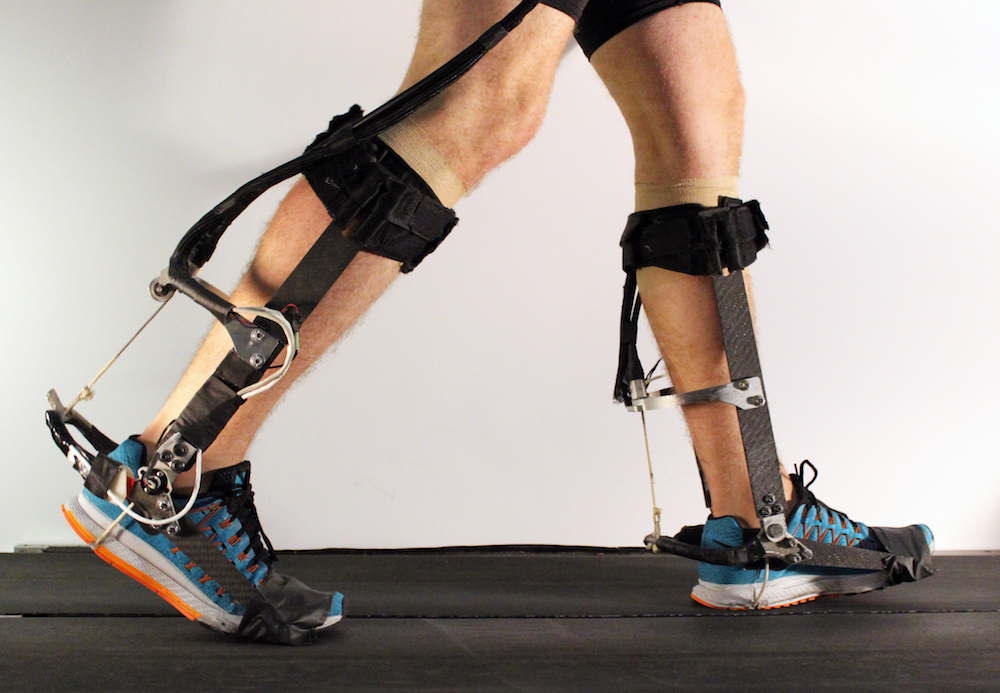Customizable 'Smart' Exoskeleton Learns from Your Steps
In experiments with 11 able-bodied people, the so-called human-in-the-loop algorithm took about an hour to optimize the exoskeleton, and afterward, reduced the amount of energy participants needed to walk by 24 percent, on average, said research team member Rachel Jackson, a postdoctoral researcher in the Department of Mechanical Engineering at Carnegie Mellon University (CMU). [Bionic Humans: Top 10 Technologies]
"The size of the reduction was pretty astounding," Jackson told Live Science.
Jackson and her colleagues, led by Steven Collins, an associate professor of mechanical engineeringat CMU, and Juanjuan Zhang, formerly of CMU and now a professor at Nankai University in China, published the results of their research online today (June 22) in the journal Science.
A lightened load is certainly appealing, but a personalized exoskeleton could also increase the distance an able-bodied person can walk, and it could even help individuals run faster, Jackson said.
People with physical impairments, such as those who have suffered a stroke, a neurological injury or an amputation, may realize benefits as well, Jackson said. A personalized exoskeleton could make walking as easy or easier than it was before an amputation or injury, she said.
Previously, the largest average energy reductions achieved by other research teams were 14.5 percent, using manually adjusted ankle exoskeletons worn on both legs, and 22.8 percent, using an exosuit that acted on both hips and both ankles using preprogrammed settings.
But the CMU human-in-the-loop algorithm performed better, and it didn't rely on preprogramming.
Get the world’s most fascinating discoveries delivered straight to your inbox.
"This algorithm was so good that it was able to discover an assistance strategy to reduce energy costs with just a single device," said Jackson. "That was pretty cool." [Top 10 Inventions that Changed the World]
The challenge with exoskeletons is that although they're meant to assist a person, they can impede motion, said Jackson. For starters, each device comes with its own weight, ranging from a few ounces to a couple of pounds, and the user has to carry that weight. Exoskeletons are also designed to apply force to certain parts of the body, but if the timing of the force is off, the person may need to use more energy to move, Jackson said. And that's counterproductive.
During the optimization phase of the recent study, each participant wore an ankle exoskeleton as well as a mask designed to measure levels of oxygen and carbon dioxide (CO2). These measures relate to how much energy the person is expending. As each person walked on a treadmill at a steady pace, the exoskeleton applied a set of different patterns of assistance to the ankles and toes.
Those patterns were a combination of when the force was applied and the amount of force. For instance, forces could be applied early in a stance (when the heel first hits the ground), in the middle of the stance (when the foot is flat) or late in stance (when the foot has rolled up to the toe). During those variations in positions, a greater or smaller amount of force could be applied.
The algorithm tested the participants' responses to 32 different patterns, which changed every 2 minutes. Then, it measured whether the pattern was making it easier or more difficult for the person to walk.
By the end of the session, which lasted just longer than an hour, the algorithm produced a unique pattern of assistance optimized for each individual.
"In terms of the general shape of the patterns, there was large variability, which speaks to the importance of customizing these strategies to each person, rather than applying that same thing to everybody," Jackson said.
She added that the device may have worked well not just because it was "learning," but also because as it changed up the pattern of assistance, the person using it was also learning.
"We think that it forces people to explore different ways of coordinating their gait to interact better with the device," Jackson said. That helps guide the person on how best to use the device and derive the greatest benefit from it. "It's a two-way street," she said.
Other members of the team plan to test how the algorithm could be scaled up to create an exoskeleton with six joints, designed to be worn on the entire lower half of the body.
Original article on Live Science.





